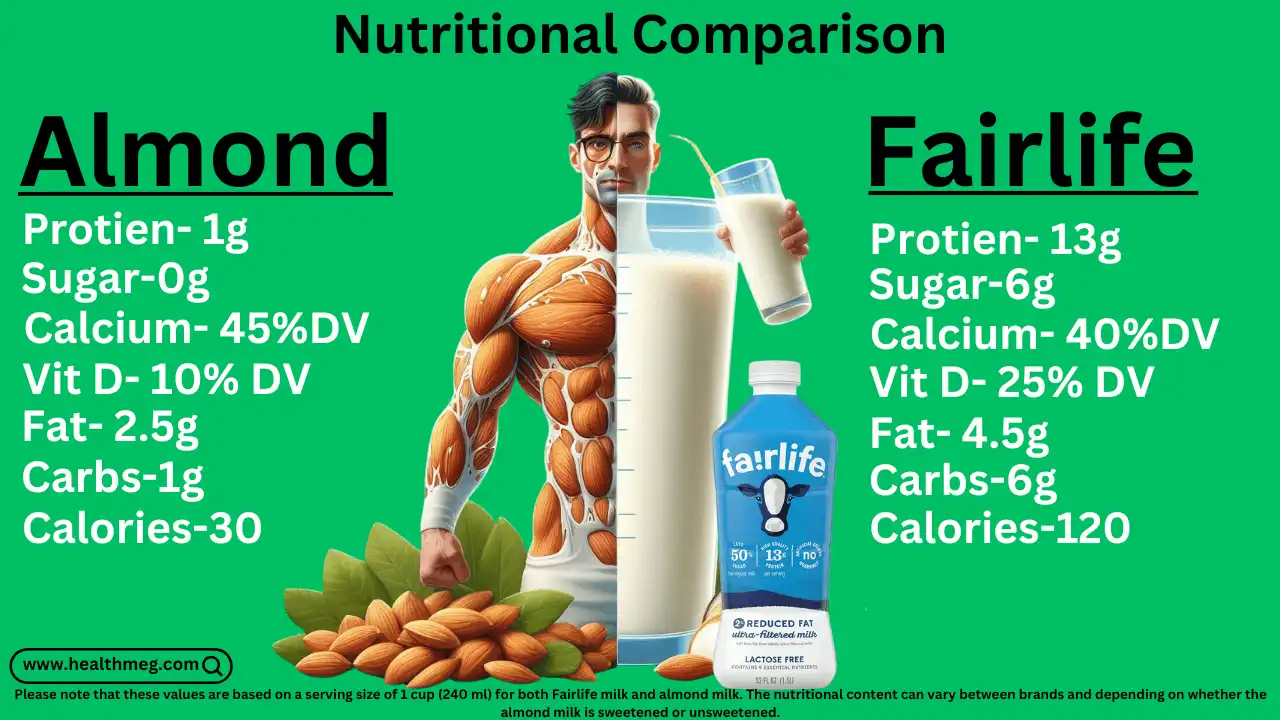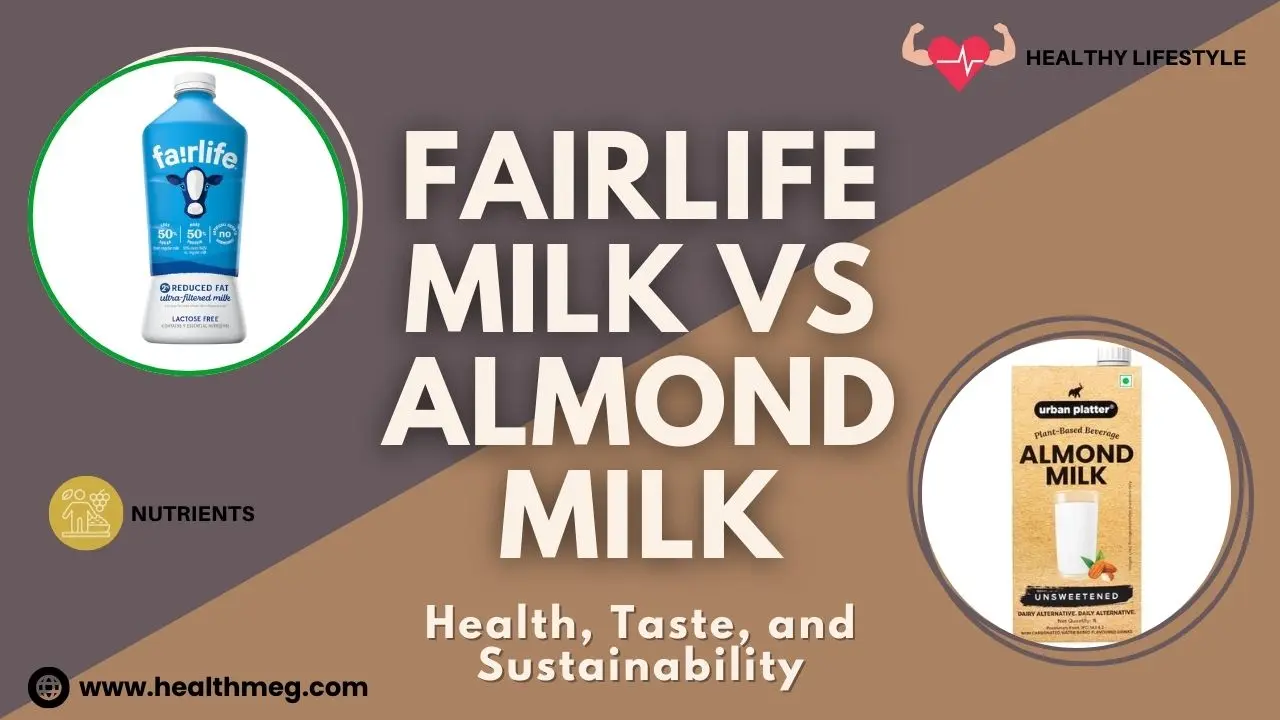Introduction
Almond milk or Fairlife? This age-old question has plagued milk-drinkers for generations. With the dairy aisle today bursting with options, the milk dilemma intensifies. Do you choose the nutty richness of almond nectar or the protein-packed punch of a filtered delight? How do you decide between the watery wonders of nuts and the creamy cup of a cow?
We’ve all found ourselves lost in the dairy aisle, grasping that frosty gallon with indecision (not to mention desperation). Which milk will win your heart, your health, or your next cereal bowl? What exactly is the difference between this plant-based product and its dairy-derived cousin? Well, fret no more!
In this utterly engaging article, we will tackle the almond milk vs Fairlife milk showdown in full force. Arm yourself with knowledge, and let’s settle this battle once and for all. With nutritional stats, taste tests, and environmental impacts at the ready, we present the Fairlife Milk vs Almond Milk: Ultimate Milk Smackdown. Let’s get ready to rumble. For more information on other milk alternatives, check out this article on oat milk and acid reflux.
Do read the People Also Ask (FAQs) about this topic.
Key Takeaway
- When comparing almond milk and Fairlife milk, Fairlife contains significantly more protein at 13g per cup, making it better for boosting protein intake. However, almond milk is lower in calories, carbs, sugar, and fat, so it’s the better option if limiting those is your priority. Both milks can fit into a healthy diet, depending on your needs.
- Almond milk provides more calcium, with 45% DV versus 35% DV in Fairlife.
- Fairlife milk has a richer, creamier taste compared to the thinner, nuttier taste of almond milk.
- Based on environmental impact, almond milk is more sustainable with lower water use and carbon emissions.
Overview of Fairlife Milk
Fairlife is a brand of ultra-filtered milk made by filtering regular cow’s milk to concentrate the protein and reduce the sugar content. The proprietary filtration process removes some natural sugars, like lactose, while concentrating the protein. This results in milk with 50% more protein, 30% more calcium, and 50% less sugar than regular cow’s milk.
Fairlife undergoes a gentle pasteurization process using cold temperatures to maintain a smooth, creamy texture and a fresh taste. It contains no artificial growth hormones and is sourced from cows not treated with the synthetic bovine growth hormone rBST. Fairlife comes in a variety of fat contents, from nonfat to whole milk, and is also lactose-free.
With its rich, indulgent taste and high protein content, Fairlife markets itself as a premium milk for “nutrition seekers”. The higher protein content makes it popular among athletes, bodybuilders, and those aiming to build lean muscle mass.
Fairlife Milk Ingredients
Fairlife milk ingredients vary slightly depending on the type of milk (whole, 1%, etc.). Here are the ingredients for a few types:
- Whole Fairlife Milk: Nonfat filtered milk (high protein, high calcium, reduced sugar), lactase enzyme, vitamin A Palmitate, vitamin D3.
- 1% Fairlife Milk: Low fat ultra-filtered milk, lactase enzyme, vitamin A palmitate, vitamin D3.
- 2% Fairlife Milk: Ultrafiltered partly skimmed milk, lactase enzyme, vitamin A palmitate, vitamin D3.
Overview of Almond Milk
Almond milk is a plant-based milk made from California almonds. To produce almond milk, raw almonds are first soaked overnight and then ground with water in a high-speed blender. The resulting slurry is strained to remove the almond pulp, leaving behind a milky liquid.
The strained almond milk has a naturally light, sweet flavour and a thin, translucent appearance. Unsweetened varieties contain just 35 calories per cup. Almond milk is naturally lactose-free, dairy-free, and vegan, making it a popular choice for vegans and those with lactose intolerance. It can also be fortified with vitamins and minerals like calcium and vitamin D.
Thanks to its low calorie count, mild flavour, and versatility, almond milk is one of the most popular nut milk varieties. It can be used as a milk substitute in everything from smoothies to baking.
Fairlife Milk vs Almond Milk: Detailed Nutritional Profile Comparison

| Nutrient | Fairlife Milk | Almond Milk | Winner |
|---|---|---|---|
| Protein | Fairlife contains 13g of protein per cup. The total protein in Fairlife milk is ultra-filtered whey protein, providing all nine essential amino acids needed for building muscle mass and supporting metabolic function. | Almond milk contains just 1g of protein per cup. | Fairlife Milk |
| Sugar | Fairlife has 6g of sugar per cup. Fairlife also offers “chocolate milk,” with just 2g sugar providing the flavour with less sugar. | Unsweetened almond milk contains 0g of sugar per cup since it’s naturally low in sugar. | Almond Milk |
| Calcium | Fairlife is fortified with calcium and provides 40% of the daily value per cup. | Almond milk is quite high in calcium, providing 45% of the daily value per cup. | Almond Milk |
| Vitamin D | Fairlife milk has 25% DV of vitamin D per cup. | Almond milk provides 10% DV of vitamin D per cup. | Fairlife Milk |
| Fat | The 2% reduced fat Fairlife milk contains 4.5g of fat per cup. | Unsweetened almond milk is very low in fat, with just 2.5g per cup. | Almond Milk |
| Carbohydrates | Fairlife milk contains 6g of carbs, including lactose and galactose, from the dairy. | Unsweetened almond milk contains just 1g of net carbs. | Almond Milk |
| Calories | Fairlife contains 120 calories per cup. | Unsweetened almond milk contains just 30 calories per cup. | Almond Milk |
Please note that these values are based on a serving size of 1 cup (240 ml) for both Fairlife milk and almond milk. The nutritional content can vary between brands and depending on whether the almond milk is sweetened or unsweetened.
Fairlife Milk vs Almond Milk: Taste and Texture Comparison
| Aspect | Fairlife Milk | Almond Milk |
|---|---|---|
| Taste | Fairlife has a richer, creamier dairy flavour, akin to whole milk. Those who love the indulgent taste of whole milk may prefer Fairlife. | Almond milk has a mildly sweet and nutty taste, though less strong than other nut milk like cashew. Those who enjoy the sweetness of plant-based milk may find almond milk more appealing. |
| Texture | Fairlife is thick and creamy. It looks opaque and white like whole milk with a fuller body. | Almond milk has a thin, watery consistency. Its low fat and protein content gives it a translucent, almost skim milk-like appearance. |
| Performance in Recipes | In hot and baked recipes, Fairlife’s higher fat and protein content makes it less likely to curdle or separate. Proteins bind better, and fat adds richness. | Almond milk can sometimes lack the structural integrity to thicken or add body. However, almond milk adds a nice subtle nutty flavour to things like smoothies, curries, or chai tea. |
| Versatility | Fairlife holds up better to heating and does well in cold preparations like smoothies. | Almond milk does well in cold preparations like smoothies and may be more versatile as a low-calorie, dairy-free option. Those with allergies or intolerances also gain options with almond milk. |
Fairlife Milk vs Almond Milk: Sustainability Comparison
Water usage:
To produce a single glass of almond milk requires just 3.5 gallons of water, compared to a hefty 106 gallons of water for one glass of Fairlife milk. Dairy production is a water-intensive process.
Carbon emissions
The carbon footprint of almond milk is significantly lower at 1.14 kg CO2 per glass, versus 1.14kg for the equivalent glass of Fairlife. The environmental impact of dairy milk production is higher due to cow digestive system methane emissions.
Based on these sustainability metrics, almond milk is clearly the more environmentally friendly option, with lower water and energy inputs. However, some concerns surround almond farming’s heavy water usage, given California’s droughts. Overall, almond milk has less environmental impact.
Fairlife Milk vs Almond Milk For Weight Loss
When it comes to weight loss, the choice between Fairlife milk and almond milk can depend on your individual dietary needs and preferences.
Fairlife Milk: This is a brand of ultra-filtered milk that is high in protein and calcium, and low in sugar. It’s also lactose-free, making it a good option for those with lactose intolerance. However, it does contain more calories than almond milk.
Almond Milk: Almond milk is a plant-based milk alternative that is lower in calories and fat compared to cow’s milk, making it a popular choice for those looking to lose weight. However, it does not provide the same amount of protein or natural vitamins and minerals as cow’s milk, including Fairlife milk.
In terms of calorie content, almond milk generally has fewer calories than Fairlife milk, which could be beneficial for weight loss. However, the higher protein content in Fairlife milk could potentially help with satiety and muscle maintenance during weight loss.
It’s important to note that both types of milk can fit into a balanced diet, and the best choice depends on your individual nutritional needs, dietary preferences, and overall eating pattern.
Fairlife Milk vs Almond Milk: Consumer Reviews and Preferences
Note: This information was gathered from a variety of sources, including consumer reviews report on Amazon.com and other reputable websites
Fairlife Milk:
- Many consumers appreciate that Fairlife milk is higher in protein and calcium, lactose-free, and contains less sugar.
- Some consumers have praised the taste of Fairlife milk, describing it as rich and creamy.
- However, some consumers have noted that Fairlife milk has a more viscous and thick texture than regular milk and a strong odour.
- Despite these concerns, Fairlife milk has been generally well received, particularly the chocolate variety.
Almond Milk:
- Almond milk is appreciated for being a low-calorie, low-fat, and low-carb alternative to dairy milk.
- It’s also praised for being a good source of calcium and vitamin D.
- Some consumers have noted that almond milk has a nutty taste, which can be a refreshing change from regular milk.
- However, some consumers have found certain brands of almond milk to be too thin in texture.
In terms of consumer preferences, the choice between Fairlife milk and almond milk often comes down to individual dietary needs and taste preferences. Those looking for a higher protein content and a creamier texture might prefer Fairlife milk, while those seeking a lower-calorie and lower-fat option might opt for almond milk. Both kinds of milk have their own unique benefits and can cater to different dietary requirements and taste profiles.
Ideal Uses and Recipes
Almond Milk
- Smoothies, protein shakes, and chia puddings
- Overnight oats and granola
- Curries, chowders, and gazpacho
- Vegan Alfredo sauce, pesto
- Baking cakes, muffins, and lighter options
Fairlife Milk
- Post-workout shakes, protein drinks
- Hot chocolate and milk-based coffee drinks
- Ice cream, creamy soups
- Savoury sauces, creamy dips, and purees
- Higher fat baking – quiche, custards, ice cream
Health Considerations
Those with nut allergies need to avoid almond milk. People with soy or lactose intolerance can drink almond milk but not Fairlife. Fairlife contains some lactose, so those with dairy allergies should avoid it.
For people with diabetes, prediabetes, or those limiting sugar, almond milk may be preferable over Fairlife.
For individuals needing higher protein like athletes or bodybuilders, Fairlife provides more protein. For vegans, vegetarians, or those wanting plant-based options, almond milk aligns with their diet.
Finally, almond milk is lower in calories and fat, so it may better suit weight loss diets or those limiting saturated fat.
Conclusion
And the winner is… both Almond and Fairlife shine in their own unique ways! In this riveting milk matchup, we’ve covered it all—nutrition, taste, sustainability, and beyond. Both bring something special to the breakfast table. Almond delights with its airy texture, natural sweetness, and wholesome nutrition stats.
Meanwhile, Fairlife flexes its ultra-filtered muscles to pack a protein punch and tantalize tastebuds. While almond milk triumphs as the environmental champion, Fairlife takes the gold for muscle-building. No single milk is objective “the best” – different folks have different favourites.
At the end of the day, milk is incredibly personal. Whether you go for a nutty, creamy, or udder-ly radical option, choose the one that makes YOU feel like the winner. That’s something we can all raise a glass to and say “Moo-ve over, we ALL make dairy look good!”
This has been your host, signing off from the Ultimate Milk Smackdown. We came for the drama but stayed for the nutritious compassion between two worthy and delightful beverage choices. Until next time, stay cool and lactose-tolerant, milk drinkers!
People Also Ask (FAQs)
Q) Is Fairlife milk better than almond milk?
A) Fairlife milk is a brand of ultra-filtered milk that is marketed as a high-protein, lactose-free, and ultra-pasteurized milk. It contains less sugar, more protein, and more calcium compared to regular milk. Almond milk, on the other hand, is a plant-based milk alternative that is often lower in calories and fat compared to cow’s milk, but it does not provide the same amount of protein or natural vitamins and minerals. Therefore, whether Fairlife milk is “better” than almond milk can depend on individual dietary needs and preferences.
Q) How long does Fairlife last after opening?
A) Once opened, Fairlife milk should be consumed within 14 days and kept refrigerated. However, the actual shelf life can depend on several factors, including how the milk is stored and the temperature of the refrigerator.
Q) Is Fairlife milk lactose-free?
A) Yes, Fairlife milk is lactose-free. This makes it a suitable choice for individuals who are lactose intolerant or have digestive sensitivities to lactose.
Q) How many carbs in Fairlife milk?
A) A one-cup serving of Fairlife milk contains only 6 grams of carbohydrates, which is half the amount found in a cup of regular milk. This makes it a great option for individuals following a low-carb or ketogenic diet.
Q) What kind of milk is Fairlife?
A) Fairlife is an American brand of ultra-filtered milk distributed by The Coca-Cola Company. In the United States, the milk comes in five flavors: reduced fat, chocolate, strawberry, fat-free, and whole milk.
Q) Does Fairlife milk cause constipation?
A) Excessive consumption of Fairlife milk may lead to constipation in some individuals due to its high protein content. However, this can vary among individuals and other factors such as individual health, diet, and hydration levels can also influence digestive health.
Q) Is Fairlife milk really healthier?
A) Fairlife milk is marketed as a healthier milk option due to its higher protein and lower sugar content. The filtration process concentrates the protein and reduces sugars like lactose. Fairlife contains 13g protein per cup compared to 8g in regular 2% milk. It also has 50% less sugar. The added protein and reduced sugar can benefit muscle building, satiety and blood sugar control. However, Fairlife is more processed and expensive. It also has more sodium and is not suitable for vegans or lactose intolerant. Overall, Fairlife can be a smart choice for some people but isn’t necessarily healthier across the board.
Q) What milk is better than almond milk?
A) There is no definitive “best” milk since different kinds of milk have different nutritional profiles and are better suited for different needs. Almond milk is extremely low in calories, carbs and sugar. But other milks may be higher in protein, calcium or other nutrients:
- Soy milk has around 7-10g protein per cup, more than almond milk’s 1g.
- Cow’s milk is highest in protein with around 8g per cup.
- Rice milk has about as much calcium as dairy milk with 30% DV.
- Hemp and flax milk have healthy omega-3 fats.
- Pea milk rivals cow’s milk with 8g protein and more calcium.
For health, sustainability, or ethical reasons you may prefer non-dairy milk. But no single milk alternative is nutritionally complete on its own. Focus on your individual needs to choose the optimal plant or dairy milk.
Q) What is the difference between Fairlife milk and milk?
A) Fairlife differs from regular milk in two main ways: protein content and sugar content. Fairlife milk goes through an ultra-filtration process to concentrate the protein and reduce the naturally occurring sugar lactose. As a result, Fairlife contains 50% more protein (13g vs 8g per cup) and 50% less sugar than regular 2% milk. The higher protein helps build muscle and aids satiety, while less sugar benefits blood sugar control. Aside from protein and sugar, Fairlife has a similar nutritional profile to 2% dairy milk in terms of calories, calcium and vitamin D. The main drawbacks are the higher cost and sodium content.
Q) Which kind of milk is the healthiest?
A) The “healthiest” milk depends on your individual nutritional needs and dietary preferences. For low-calorie and carbs, unsweetened almond or soy milk are good choices. For higher protein, cow’s milk or pea milk provides 8g per cup. Rice milk has the most calcium while hemp milk offers omega-3s. Those avoiding dairy may prefer plant-based milk like oats or cashews. Organic, local pasture-raised dairy provides nutrition without hormones or antibiotics. And lactose-free milk like Fairlife is easier to digest for some. Consider your priorities and restrictions to determine the optimal milk for you.
Q) Why not buy Fairlife milk?
A) Potential reasons to avoid buying Fairlife milk include:
- High cost – it’s around 2x the price of regular milk per gallon.
- Higher in sodium – contains around 150mg sodium vs 100mg in regular milk.
- Contains lactose – may not be suitable for lactose intolerance.
- Risk of allergies or sensitivities to common dairy proteins like casein.
- Not organic, local or grass-fed – some prefer these for sustainability or ethics.
- Requires ultra-processing and more packaging.
- Still ultimately a dairy milk, so not suitable for vegans.
- Taste – some dislike the tangy or chalky mouthfeel.
If these factors aren’t concerns for you, then Fairlife can be a nutritious milk choice. But for those with specialized diets, dairy issues, or on a tight budget, it may not be the optimal choice.
Q) Why is fairlife milk so popular?
A) Fairlife has gained popularity for several key reasons:
- Higher protein – the 13g protein appeals to athletes, bodybuilders, and anyone aiming to build muscle or aid recovery.
- Lower in sugar – with 50% less sugar than regular milk, it appeals to those managing diabetes or limiting sugar.
- Lactose-free – suitable for those with lactose intolerance who still want a milk beverage.
- Rich, indulgent taste – some prefer the creamier texture over skim or reduced-fat milk.
- Effective marketing campaign – Fairlife’s marketing highlights its nutritional benefits and positions it as a premium, protein-rich milk.
The combination of extra protein, less sugar, lactose-free status, and savvy marketing has driven Fairlife’s growing consumer base. However, it’s not right for everyone due to cost, additives, and sustainability concerns.
Q) Is almond milk the healthiest milk?
A) Almond milk makes a healthy choice, but no single milk emerges as the definitively “healthiest.” Some pros of almond milk:
- It’s low in calories, carbs, and sugar – just 35 calories and 1g net carbs per cup.
- It’s naturally dairy-free and vegan.
- It’s high in vitamin E and often calcium-fortified.
However, almond milk is not nutritionally complete on its own:
- It’s very low in protein with just 1g per cup.
- It lacks key vitamins like B12 unless fortified.
- Not a good source of omega-3 fatty acids.
- Concerns over the sustainability of almond farming.
For a balanced diet, almond milk should be enjoyed as part of an overall healthy lifestyle, not a nutritional panacea. The “healthiest” milk depends on your individual needs and dietary preferences.
Q) What milk is closest to almond milk?
A) The milk nutritionally and texturally closest to almond milk are:
- Oat milk – Similar light texture, mild natural sweetness, and low calorie/carb profile. contains 2-3g protein per cup.
- Rice milk – Very low in calories (50 per cup), carbs, and protein like almond milk. Also thin and sweet. Higher in natural sugars.
- Light soy milk – Closest in protein to almond milk with 3-4g per cup. Also low fat, naturally dairy-free, and low carb.
- Skim milk – The conventional dairy milk closest in mouthfeel and translucent appearance to almond milk. But contains lactose.
- Coconut milk – Imparts subtle natural sweetness and nutty flavour like almond milk. Higher in fat though.
So for a true almond milk twin, opt for oat or rice milk. But skim dairy milk and light soy milk come nutritionally close.
Q) Which milk has the highest protein?
A) The milk with the highest protein content per 8 oz serving is:
- Cow’s milk: 8g
- Pea milk: 8g
- Soy milk: 7-10g
- Fairlife milk: 13g
- Hemp milk: 3g
- Almond milk: 1g
Cow’s milk naturally has the most protein, while plant-based options like pea, soy, and hemp milk can also provide significant protein, rivalling dairy. Fairlife tops the list with its ultra-filtered 13g protein per serving. Almond milk trails at just 1g protein. Choose cow, pea, soy or supplemented plant-based milk for the highest protein levels.
Q) What milk is closest to fairlife?
A) There are a few kinds of milk that come nutritionally close to Fairlife milk:
- Regular 2% cow’s milk – Closest conventional dairy milk. Fairlife starts as 2% milk then gets filtered to concentrate protein. Both 2% and Fairlife contain 120 calories and 300mg of calcium per cup.
- Lactose-free 2% milk – These contain similar levels of protein, calcium, and other nutrients compared to Fairlife. Also lactose-free. Doesn’t undergo the same filtration though.
- Pea milk – Contains around 8g protein per cup, close to Fairlife’s 13g. Also has added calcium and vitamin enrichment. Vegan option.
- Soy milk – Some soy milk varieties are enriched with extra protein, calcium, and vitamin D to mimic Fairlife’s nutritional profile. Also lactose-free.
While no milk perfectly replicates ultra-filtered Fairlife’s nutritional stats, these options provide the closest comparison while aligning with different dietary needs.












